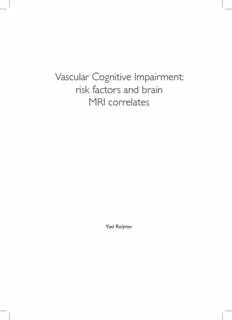
Microstructural White Matter Abnormalities and Cognitive Functioning in Type 2 Diabetes PDF
Preview Microstructural White Matter Abnormalities and Cognitive Functioning in Type 2 Diabetes
Vascular Cognitive Impairment: risk factors and brain MRI correlates Yael Reijmer Cover image: Els Freeke Lay-out: Roy Sanders Printed by: Ridderprint ISBN: 978-90-393-5728-6 © 2012 Y.D. Reijmer All rights reserved. No part of this publication may be reproduced or transmitted in any form or by any means, without permission in writing from the author. The copyright of the articles that have been published has been transferred to the respective journals. Vascular Cognitive Impairment: risk factors and brain MRI correlates Vasculaire cognitieve beperkingen: risicofactoren en gerelateerde hersenschade op MRI (met een samenvatting in het Nederlands) Proefschrift ter verkrijging van de graad van doctor aan de Universiteit Utrecht op gezag van de rector magnificus, prof.dr. G.J. van der Zwaan, ingevolge het besluit van het college voor promoties in het openbaar te verdedigen op donderdag 9 februari 2012 des middags te 4.15 uur Door Yael Dorit Reijmer Geboren op 7 januari 1982 te Jeruzalem, Israel Promotor: Prof.dr. L.J. Kappelle Co-promotoren: Dr. G.J. Biessels Dr. E. van den Berg Financial support by the Dutch Heart Foundation and the Diabetes Fonds for the publication of this thesis is gratefully acknowledged. Additional financial support was generously provided by the Alzheimer Nederland (Bunnik), Internationale Stichting Alzheimer Onderzoek and Boehringer Ingelheim. Contents Chapter 1 General introduction and outline of the thesis 9 Part I: The development of VCI over time in individuals with type 2 diabetes mellitus Chapter 2 Cognitive dysfunction in patients with type 2 diabetes 21 Chapter 3 A 4 year follow-up study of cognitive functioning in patients 51 with type 2 diabetes mellitus Chapter 4 Accelerated cognitive decline in patients with type 2 67 diabetes: MRI correlates and risk factors Part II: Exposure to vascular risk factors and VCI Chapter 5 Development of vascular risk factors over 15 years in 85 relation to cognition: the Hoorn study Chapter 6 Dementia risk score predicts cognitive impairment after a 105 period of 15 years in a non-demented population Chapter 7 The metabolic syndrome, atherosclerosis and cognitive 117 functioning in a non-demented population: the Hoorn study Part III: Microstructural white matter correlates of VCI Chapter 8 Constrained spherical deconvolution based tractography and 139 cognition in Alzheimer’s disease Chapter 9 Microstructural white matter abnormalities and cognitive 159 functioning in type 2 diabetes: a diffusion tensor imaging study Chapter 10 General discussion 177 Chapter 11 Summary 191 Nederlandse samenvatting 197 List of publications 205 Acknowledgements 209 Dankwoord 213 Curriculum Vitae 219 Chapter 1 General introduction Chapter 1 Vascular cognitive impairment Dementia affects around 7% of the general population over 65 years, and 30% of people over 80 years.1,2 The prevalence of dementia is expected to double over the next 30 years3, making disorders of cognition a priority for healthcare and social-care services. Alzheimer’s disease and vascular dementia are the two most common forms of dementia, accounting for over 75% of all dementia cases.4 Although Alzheimer’s disease and vascular dementia have been considered two separate entities for decades, we now know that the majority of older individuals with dementia show mixed pathology, despite the clinical diagnosis.5 In fact, there is probably a continuum in underlying pathologies ranging from patients with pure vascular dementia to pure AD6. The close relation between vascular dementia and Alzheimer’s disease is further supported by studies showing that risk factors for cerebrovascular disease such as hypertension, obesity, hypercholesterolemia, and hyperglycemia are also risk factors for Alzheimer’s disease.7,8 These findings have lead to the introduction of the concept ‘vascular cognitive impairment’ (VCI). VCI refers to all forms of mild to severe cognitive impairment associated with, and presumed to be caused by, cerebrovascular disease.9 Given the important role of cerebrovascular disease in the development of cognitive decline, further research into progression rates, risk factors and imaging changes of VCI is needed to gain insight in possible mechanisms and to develop effective treatment strategies. The current emphasis in the literature on VCI is on the late stages of cognitive decline, i.e. dementia. However, twice as many people suffer from more mild forms of cognitive impairment.10,11 Examination of underlying mechanisms of these early stages of cognitive dysfunction is relevant, because treatment benefits are expected to be largest when the underlying brain damage is still relatively modest. Moreover, mild cognitive deficits are a problem by itself, leading to complaints and affecting functional abilities, also in individuals who will not progress to dementia.12,13 Addressing mild cognitive deficits will therefore help to identify a much larger group of individuals who can benefit from treatment strategies. The present thesis focuses on these milder forms of vascular related cognitive impairment by addressing i) their course of development (first part), ii) vascular risk factors (second part), and iii) cerebral white matter correlates (third part). The following paragraphs will give a short introduction to the different research questions addressed in each chapter. 10
Description: